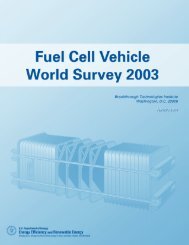Breakthrough Technologies Institute - Fuel Cells 2000
Breakthrough Technologies Institute - Fuel Cells 2000
Breakthrough Technologies Institute - Fuel Cells 2000
You also want an ePaper? Increase the reach of your titles
YUMPU automatically turns print PDFs into web optimized ePapers that Google loves.
independently of the electric grid. The police station was one of the few facilities with<br />
lights and power during the city’s widespread power outage in 2003.<br />
Grand Central Terminal, Manhattan: Two UTC Power 200-kW PAFC systems were<br />
installed by NYPA in 2005 to provide power for critical security loads even during a local<br />
power failure. Partially funded by NYSERDA.<br />
New York Hilton Hotel, Manhattan: Installed in 2005, the UTC Power 200-kW PAFC<br />
provides power and 100% waste heat recovery for hot water in guest rooms, kitchens<br />
and laundry. Partial funding provided by NYSERDA under its Distributed<br />
Generation/Combined Heat and Power (distributed generation/CHP) program.<br />
Sheraton Hotel New York Hotel & Towers, Manhattan: The <strong>Fuel</strong>Cell Energy 250-kW<br />
MCFC provides about 10% of the power and hot water requirements of the 1,750 room<br />
hotel. Partial funding provided by NYSERDA. The fuel cell was installed in 2004.<br />
SUNY College of Environmental Science and Forestry, Syracuse: Installed by<br />
NYPA in 2005, the <strong>Fuel</strong>Cell Energy 250-kW MCFC provides electricity with waste heat<br />
used for hot water, space heating and/or cooling at Walters Hall. Partial funding by<br />
NYSERDA.<br />
Rural residence, Tompkins: As an alternative to running wires to homes in remote<br />
locations, the Delaware County Electric Cooperative is demonstrating a Plug Power 5kW<br />
fuel cell that is integrated with a power electronics and battery storage system to<br />
manage the electrical loads dynamically and provide the peak energy needs of the<br />
residence. The system is continually charged by the fuel cell during “off-peak” times.<br />
The project is funded by NYSERDA and through at grant provided under a U.S.<br />
Congressional Earmark to investigate the viability of fuel cells for rural applications.<br />
West Babylon <strong>Fuel</strong> Cell farm, West Babylon: The Long Island <strong>Fuel</strong> Cell Farm R&D<br />
project at the West Babylon substation has been the focal point of LIPA’s fuel cell<br />
program. In October 2001, LIPA announced that 75 Plug Power fuel cells were<br />
connected to the grid. This project was the first grid connection of fuel cells of this size in<br />
the world. As of November 2003, there are 45 units installed.<br />
Yonkers Waste Water Treatment Plant, Yonkers: World’s first anaerobic digester<br />
gas-fueled fuel cell. The UTC Power 200-kW PAFC was installed in 1997 by NYPA.<br />
Water Pollution Control Plants (Ward 26, Red Hook, Oakwood Beach, Hunts Point)<br />
located at Brooklyn, Bronx and Staten Island: Two 200-kW UTC Power PAFC units<br />
are located at each plant, converting waste gas into energy to help power the facilities.<br />
The installations are a joint project of NYPA, NYSERDA and the New York City<br />
Department of Environmental Protection. The program reduces harmful greenhouse gas<br />
emissions and helps to eliminate the release of noxious gas into the air and this process<br />
is expected to eliminate nearly 170 tons of regulated emissions and more than 9,000<br />
tons of the greenhouse gas carbon dioxide, and reduce fuel oil consumption by 3,000<br />
barrels a year. The cost of the fuel cell program is $13 million. NYPA provided $10.5<br />
million and NYSERDA and DOE provided more than $2.5 million to co-fund the initiative.<br />
The fuel cells were installed in 2003.<br />
155






